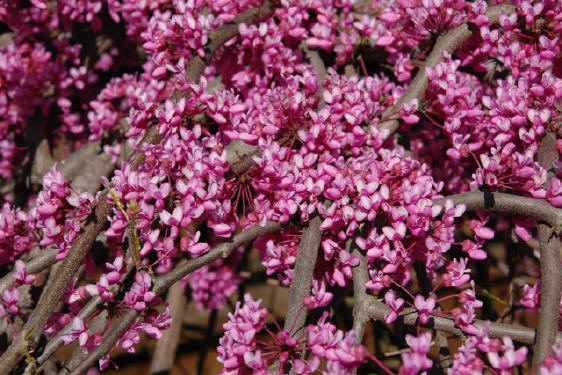Susie Quinlan Hill
Frederick County Master Gardener
 (5/9) I was twenty-two when I first moved to Hyden, Kentucky in rural Appalachia. I arrived in mid-March when there was talk of an upcoming Redbud Festival. The people in Hyden understood that the blossoming of this magnificent tree is something to be celebrated. Once I saw
the mountains draped in magenta flowers, I understood.
(5/9) I was twenty-two when I first moved to Hyden, Kentucky in rural Appalachia. I arrived in mid-March when there was talk of an upcoming Redbud Festival. The people in Hyden understood that the blossoming of this magnificent tree is something to be celebrated. Once I saw
the mountains draped in magenta flowers, I understood.
If you are not familiar with the Eastern redbud, it is a native understory tree that is common in our woodlands and often used in landscaping because of its striking flowers. The bloom time lasts only several weeks so it is a fleeting display, but one to be savored. The flowers bloom all along the stems, botanically referred to as cauliflory. The
word cauliflory literally translates to "stem flower" and it is unusual in flowering trees. This feature allows the flowers to highlight the shape of the tree. In Hyden, people came out from their homes in the hollers to join their community in celebrating the beauty of this harbinger of spring.
In addition to having my eyes opened to the magenta swaths of flowers on the mountainside, I learned a great deal about food preservation methods while living in Hyden. I learned about canning peaches, drying beans, and freezing corn. No one ever mentioned, however, that redbuds are an edible food source. I was well into my adulthood before I
learned that redbud flowers are edible. At an historical event at the Schifferstadt museum in downtown Frederick, I was served a colonial style candy made from dried redbud flowers and mint, sweetened with sugar. It wasn’t the most delicious candy I’ve ever eaten, but it piqued my curiosity. I later found out that Native American Indians ate the flowers raw and they
boiled and roasted the seeds. Seeds left behind were, and still are, enjoyed by seed eating birds in the winter like quail, pheasants, and goldfinches.
Although the idea of boiling and roasting redbud seeds does not appeal to me, it tickles me to eat the flowers raw. The flowers taste like peas, which is no surprise given that they are legumes. Obviously, before eating any food from the wild, one must be certain that he or she has correctly identified the plant using multiple reliable sources.
Having a horticulturist for a mother, my three children are able to easily identify redbuds. With this certainty and my approval, my kids always took pride in being able to introduce their friends to redbuds and watch their faces as they cautiously nibbled the flowers for the first time. The best part of introducing children of any age to the fact
that our native redbuds, Cercis canadensis, are edible is watching their faces as they explore something new.

Every spring, Eastern redbuds offer a magical display of magenta flowers that is a feast for the eyes- both in nature and in the cultivated landscape. Their short-lived flower display offers a chance to enjoy the novelty of an edible flower that may or may not be considered delicious. When it comes to the seeds, I don’t know anyone who has tried
boiling and roasting them and I have no intention of trying it anytime soon. This winter, a hungry goldfinch may be glad that I left them behind.
Read other articles about trees
Read other articles by Susie Hill